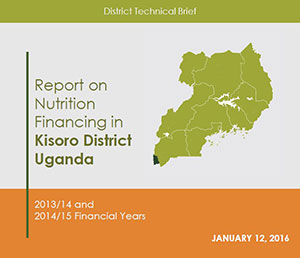
Introduction
1.1 Ugandan Nutrition Action Plan
The global Scaling Up Nutrition (SUN) Movement calls for action and investment to improve maternal and child nutrition. The Government of Uganda (GoU) has committed itself to the SUN principles, a commitment that culminated in the development of the Uganda Nutrition Action Plan (UNAP), 2011–2016. The UNAP outlines GoU’s dedication to fulfilling its obligation of ensuring food and nutrition security for all Ugandans, especially those living in areas reported to have the highest levels of malnutrition. UNAP was launched in November 2011 and is coordinated by the Office of the Prime Minister (OPM).
The ultimate goal of the UNAP is to reduce levels of malnutrition among women of reproductive age, infants, and young children through 2016. Ensuring that all Ugandans are properly nourished will enable them to live healthy and productive lives. To achieve this goal and to improve the nutrition status indicators, the UNAP has five strategic objectives that will be pursued through 2016. Under these five objectives, the UNAP has 13 strategic areas, as shown in table 1.1.
Table 1.1. UNAP Objectives and Strategic Areas
| Objective 1: Improve access to and utilization of services related to maternal, infant, and young child nutrition. | Strategy 1.1: Promote access to and utilization of nutrition and health services to all women of reproductive age, infants, and young children. |
| Strategy 1.2: Address gender and socio-cultural issues that affect maternal, infant, and young child nutrition. | |
| Objective 2: Enhance consumption of diverse diets. | Strategy 2.1: Increase access to and use of diverse nutritious foods at the household level. |
| Strategy 2.2: Increase post-harvest handling, storage, and utilization of nutritious food at the household and farm levels | |
| Strategy 2.3: Promote the consumption of nutrient-enhanced foods. | |
| Objective 3: Protect households from the impact of shocks and other vulnerabilities that affect their nutritional status. | Strategy 3.1: Develop preparedness plans for shocks. |
| Strategy 3.2: Promote social protection interventions for improved nutrition | |
| Objective 4: Strengthen the policy, legal, and institutional frameworks and the capacity to effectively plan, implement, monitor, and evaluate nutrition programs. | Strategy 4.1: Strengthen the policy and legal frameworks for coordinating, planning, and monitoring nutrition activities. |
| Strategy 4.2: Strengthen and harmonize the institutional framework for nutrition from the local to the central government level. | |
| Strategy 4.3: Strengthen human resource capacity to plan, implement, monitor, and evaluate food and nutrition programs in the country. | |
| Strategy 4.4: Enhance operational research for nutrition | |
| Objective 5: Create awareness of and maintain national interest in and commitment to improving and supporting nutrition programs in the country. | Strategy 5.1: Increase awareness of and commitment to addressing nutrition issues in the country. |
| Strategy 5.2: Advocate for increased commitment to improving nutrition outcomes. |
1.2 Pathways to Better Nutrition Case Study
With support from SPRING, Deutshe Stiftung Weltbevoloelkerung (DSW) prepared this district budget analysis for the Pathways to Better Nutrition (PBN) case study to generate evidence on government investments to effectively implement planned activities under the UNAP at the district level. The PBN case study explores whether the GoU and its development partners are making the necessary financial investments to enable the roll out the UNAP activities in two selected districts—Lira and Kisoro.
The key domains of inquiry of the PBN study are—
- Learning, adaptation, and evidence on scale-up
- Adaptation of innovations/interventions to context(s)
- Financing of nutrition activities
- Long-term planning for sustainability
The PBN case study’s overall objectives are to explore the relative emphasis given to the nutrition-specific and nutrition-sensitive activities and how prioritization of these activities affects the financial resources allocated. The district budget analysis presented here supports the creation of evidence around the last two domains. For this work, DSW defined several district-level objectives:
- Document government nutrition activities at the district government level using UNAP as a benchmark.
- Analyze how the local government (LG) prioritizes nutrition interventions and supports the implementation of the UNAP to reach its chosen goals of reducing undernutrition.
- Analyze whether the LGs and their development partners make the necessary investments to implement the UNAP activities.
This district budget analysis (largely quantitative) is complemented by qualitative analysis, which focused more on the first two study domains.
1.3 Methodology
DSW followed the overall SPRING PBN study protocol. The study was done using a ‘q-squared’ methodology, which means the analysis of quantitative trends and patterns was complimented with a qualitative understanding of the underlying budget allocations. This allowed the research team to validate and triangulate the quantitative findings with input from district officials. In this way, the quantitative budget analysis was integrated with qualitative work that focused on identifying nutrition-sensitive and -specific allocation by district officials.
Box 1. Basic Definitions
Nutrition-specific interventions: target the immediate causes of undernutrition: inadequate dietary intake and ill health.
Nutrition-sensitive interventions: Unlike nutrition-specific interventions, nutrition-sensitive interventions lack a common definition. Nutrition-sensitive interventions seek to promote adequate nutrition as the goal of national development policies in agriculture, food security, social protection, health, and education programs. These interventions aim to address poverty, gender inequality, food insecurity, and/or lack of access to education, health, clean water, and other basic services.
The analysis of nutrition budget allocations was based on the UNAP, which has five objective areas (see table 1.1), four sectors (education; health; agriculture; gender, labor, and social development community-based services) and water. Although the UNAP does not explicitly include water, under UNAP strategy 1.1, there is an emphasis on the promotion of proper food-handling hygiene, and sanitation through increased knowledge, use of safe water, and handwashing practices at the household level. Additionally, promotion of safe water is the water sector’s mandate. It is for these reasons that this analysis includes the water sector.
Within the sectors named by UNAP and water, only some activities are considered nutrition-specific or nutrition–sensitive (see box 1). Even among these activities, some may be integrated so that only a percentage of the funds are allocated to nutrition activities (for instance, a budget item for antenatal care provision is only partially related to nutrition).
The following steps were taken to identify, validate, and analyze nutrition-related allocation:
- DSW teams obtained copies of the district and Lira Regional Referral Hospital (LRH) work plans and budgets from the financial years 2012/13 and 2014/15. Other agencies (National Medical Stores [NMS] and nongovernmental organizations [NGOs]), provided only their budget and spending information.
- A data extraction tool was developed in an Excel spreadsheet to help capture information from all sources.
- Information was entered into the Excel tool format. For the district and LRH, the tool captured information on all budget lines for each of the five sectors.
- The first draft of the completed tool was shared in advance with district officials from the five key sectors, LRH, donors, and NGO officials in the two districts to review and verify the information.
- The DSW team had in-person meetings with the heads of sectors in the two districts and the administrator of LRH. During the interactions, the heads of sectors, including other staff, identified nutrition-relevant activities in their sector budgets, substantiated their activities by providing examples, related the budget line to UNAP strategic areas, and estimated how much of the allocation was for nutrition.
- The DSW team compiled the responses and developed the methodology to translate them into percentages. The percentages were allocated as follows:1
- No activity – 0 percent
- Little activity – 10 percent
- Moderate – 50 percent
- Many activities – 70 percent
- Most of the activities – 80 percent
- All activities – 100 percent
- Using the percentages allocated for each budget line, the DSW team aggregated the amounts to generate the total amount for the sector. Then, the team aggregated the amounts for the five sectors to generate the total amount for the district.
- After review and triangulation, data were analyzed in Excel to generate the information that allowed for the writing of this report.
It should be noted that while the percentages are only estimates, the data generated provides an indication of how much districts and other agencies spend on nutrition-related activities.
The full methodology for budget analysis at the national and district levels in Uganda can be accessed at: https://www.spring-nutrition.org/publications/briefs/annex-spring-pathways-better-nutrition-budget-methods-uganda.
1.4 Scope
The study was carried out in Lira and Kisoro districts and covered two financial years: 2013/14 and 2014/15. Details on the Kisoro study are available in a sister report by SPRING, “Pathways to Better Nutrition Case Study Evidence Series – Uganda: Report on Nutrition Financing in Kisoro District– 2013/2014 and 2014/15 Financial Years.”
To be selected, districts needed to meet at least one of the following criteria:
- be an early adopter of the UNAP district and sub-district committee structures
- participate in Community Connector
These criteria are related to the district’s relative progress in rolling out the UNAP and the availability of district-representative secondary quantitative data to complement SPRING’s case study findings.
SPRING also considered geographic location and region to increase diversity of context, following the “most different” methodology used to select country cases. Finally, to avoid the appearance of self-evaluation, only one of the two districts selected also contains SPRING implementation activities.
Kisoro district is located in the southwestern part of Uganda and is bordered by Democratic Republic of Congo to the west; Rwanda in the south; and Kabale and Kanungu district to the east and north, respectively. The total land area of Kisoro district is 729.6 square kilometers. The district population is estimated to be 287,179 people (UBOS 2014). The district is made of 13 sub-counties and one Town Council. It has a total of 389 villages, 36 parishes, and two town wards.
The district’s economy is very poor, with more than 89 percent of the of the households dependent on subsistence farming; growing crops like potatoes, beans, peas, maize, sorghum, millet, wheat, sweet potatoes; and raising goats, sheep, cows, rabbit, cattle, and pigs. However, the 510 km distance from the capital, rough hilly terrain, lack of technologies and facilities for agro-processing, and few opportunities for value addition affects the marketability of the agricultural products, leading to low agricultural incomes. Due to a low revenue base and limited options in agriculture, the district depends on tourism activities, especially from Bwindi Impenetrable National Park (BINP) and Mgahinga Gorilla National Park (MGNP).
1.5 Challenges
It is inherently difficult to parse out nutrition financing because it does not have its own sector or line items within the sector budgets. As such, the results are from approximations of nutrition funding. Limitations included—
- In the sector work plans and budgets, wages are centralized in the administration budget and not captured in the respective sector budgets. Thus, we were not able to capture wages in the total sector allocation.
- The Output Budgeting Tool (OBT) the districts used to prepare their budgets is very restrictive, and makes it difficult to capture activities in detail for each budget line. It is thus difficult to disaggregate nutrition-related allocation.
- There are several NGOs implementing nutrition-related projects at the district level, and some were reluctant to provide information on their projects. Those who did provided it in aggregate format, making analysis for each financial year very difficult. In addition, most NGOs were not able to provide information for FY 2014/15.
- Despite the willingness of the NMS to provide data on nutrition spending, they were unable to provide data for FY 2014/15.
1.6 Structure of the Report
Findings in this report are divided into seven sections. Section 2.1 looks at the overall budget for Kisoro district. Section 2.2 looks at nutrition budget allocations within the district government. Sections 2.3 and 2.4 look at budget allocations within Medical Supplies and external funding from NGOs and development partners, respectively. Section 2.5 provides the overall nutrition allocation for Kisoro, and section 2.6 includes additional observations. Finally, section 3 provides a summary of findings, conclusions, and recommendations.
Findings
2.1 Overall Budget
Sources of revenue
The three major revenue sources for the district are local revenues, central government (CG) transfers, and donor on-budget funding. All other donor funding is considered off-budget, or is run outside the government system. In nominal terms, the district projected revenue was Shs 24.9 billion and Shs 32.4 billion for FY 2013/14 and FY 2014/15, respectively (see figure 2.1).
Figure 2.1. Kisoro District Revenue Sources
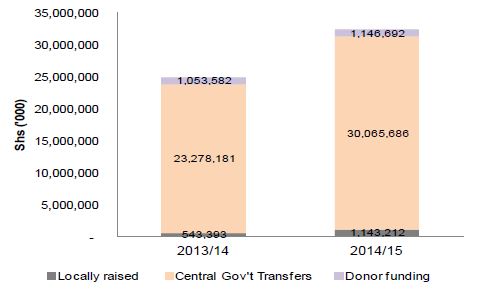
Kisoro district largely depends on CG transfers, which were 94 percent and 93 percent of the total revenues for FY 2013/14 and FY 2014/15, respectively. It should be noted that the largest percentage of CG transfers are conditional in nature (see figure 2.2); they are biased toward the national priority program areas (NPPA). This severely limits the ability of the district to allocate funds as it may wish. If no other discretionary funds are available to support the district for the UNAP rollout, the district will have little control over the allocation of funds for nutrition-related spending.
Figure 2.2: Composition of CG Transfers to Kisoro District
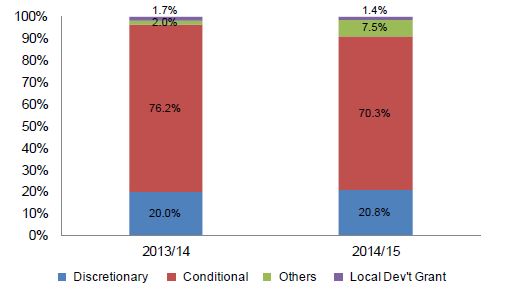
Budget Allocation
The district budget is allocated to 12 sectors, which include Administration, Community-Based Services, Education, Finance, Health, Internal Audit, Natural Resources, Planning, Production (agriculture) and Marketing, Roads & Engineering, Statutory Bodies, and Water.
The education sector took more than half of the total district allocation; 42.7 percent in 2013/14 and 53.1 percent in 2014/15. The share of allocation to the other three sectors (named in UNAP) and water was 25.9 percent in 2013/14 and 15.0 percent in 2014/15 (see table 2.1).
Table 2.1. Kisoro District Budget Allocations
| Sector | 2013/14 | 2014/15 | ||
|---|---|---|---|---|
| Amount (‘000) | Share | Amount (‘000) | Share | |
| Education | 10,627,950 | 42.7% | 17,180,803 | 53.1% |
| Health | 5,728,880 | 23.0% | 6,799,621 | 21.0% |
| Administration | 3,706,422 | 14.9% | 1,692,739 | 5.2% |
| Production | 1,479,663 | 5.9% | 884,061 | 2.7% |
| Roads & Engineering | 706,080 | 2.8% | 1,087,525 | 3.4% |
| Water | 863,967 | 3.5% | 1,237,710 | 3.8% |
| Statutory Bodies | 599,216 | 2.4% | 689,090 | 2.1% |
| Community Based Services | 401,804 | 1.6% | 1,047,582 | 3.2% |
| Finance | 446,746 | 1.8% | 666,168 | 2.1% |
| Planning | 143,228 | 0.6% | 740,692 | 2.3% |
| Natural Resources | 104,015 | 0.4% | 239,909 | 0.7% |
| Internal Audit | 67,185 | 0.3% | 89,688 | 0.3% |
| Total | 24,875,156 | 100% | 32,355,588 | 100% |
Source: Author’s calculation based on Kisoro District Budget Estimates
A further analysis of allocation on the four sectors (named in UNAP) and water, show a larger amount of the allocation is recurrent (wage and non-wage). Recurrent allocations were 83.4 percent and 86.8 percent in 2013/14 and 2014/15, respectively (see figure 2.3). The higher share of recurrent allocation is attributed to the high wage component in the education- and health-sectors. It should be noted that recurrent spending is non-fungible; therefore, only a small amount of the district funds can be re-prioritized.
Figure 2.3. Kisoro Composition of UNAP and Water Sector Allocation
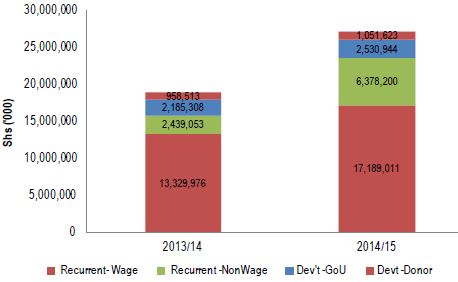
It should be noted that all donor funds are categorized as part of the development budget; which increases the percentage of development spending. However, development spending is not just for capital spending (e.g., building new facilities, repairs to existing physical assets). The development spending is heavily oriented toward non-wage recurrent expenditures (such as buying vehicles, paying allowances) rather than capital expenditures. The low level of capital spending has negative implications on infrastructure development, which is critical to provision and the sustainability of nutrition-related activities.
2.2 Nutrition (Specific and Sensitive) Budget Allocations
2.2.1 Kisoro District Budget Allocation
The total Kisoro nutrition (specific and sensitive) budget allocation for the four sectors (named in UNAP) and water was Shs 1.44 billion in FY 2013/14 and Shs 1.54 billion in FY 2014/15 (see table 2.2 and figure 2.4). The share of nutrition-related budget allocation to the total allocation for the five sectors is estimated at 8.0 percent in 2013/14 and 6.1 percent in 2014/15. Contrary to the belief that nutrition allocation is primarily in health, there is high nutrition sensitive allocation in production (agriculture), especially on food production. The production sector has the highest share (on average during the last two FYs) of nutrition-related allocations of 24.8 percent; this is followed by health at 14.2 percent, water and community-based services at 10 percent each, and education at 1.9 percent.
Figure 2.4: Total Kisoro District Budget Allocations
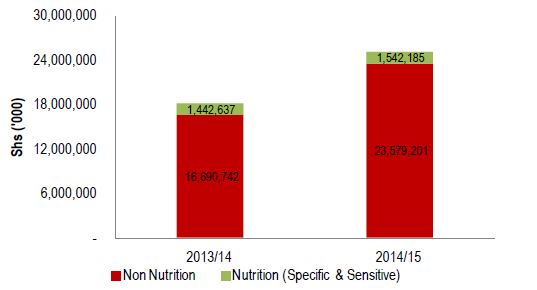
Table 2.2. Kisoro Total Nutrition (specific and sensitive) Budget Allocations (figures in Shs ‘000)
| Sector | 2013/14 | 2014/15 | ||||
|---|---|---|---|---|---|---|
| Total | Nutrition (Specific & Sensitive) | Share | Total | Nutrition (Specific & Sensitive) | Share | |
| Health | 5,681,559 | 824,592 | 14.5% | 6,553,638 | 909,799 | 13.9% |
| Production | 1,429,996 | 300,280 | 21.0% | 833,049 | 237,631 | 28.5% |
| Education | 10,007,749 | 216,357 | 2.2% | 16,598,796 | 281,164 | 1.7% |
| Water | 837,186 | 83,719 | 10.0% | 922,499 | 92,250 | 10.0% |
| Community-Based Services | 176,889 | 17,689 | 10.0% | 213,404 | 21,340 | 10.0% |
| Total | 18,133,379 | 1,442,637 | 8.0% | 25,121,386 | 1,542,185 | 6.1% |
Source: Author’s calculation based on Kisoro District sector work plan
2.2.2 Nutrition by Sector
Health Sector
The total health budget was Shs 5.7 billion in 2013/14 and Shs 5.6 billion in 2014/15 of which the amount allocated for nutrition-related activities were Shs 825 million and Shs 910 million in 2013/14 and 2014/15, respectively (see figure 2.5). The largest amount of the health sector nutrition allocation was on health care management services and NGO hospital services (see annex 1).
Figure 2.5. Kisoro Health Sector Nutrition-Related Allocation
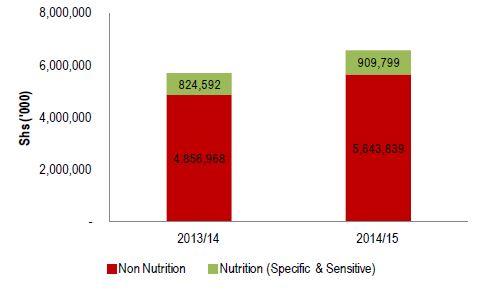
Production (Agriculture) Sector
The total production (agriculture) sector budget was Shs 1.4 billion in 2013/14 and Shs 833 million in 2014/15; the amount allocated for nutrition-related activities were Shs 300 million and Shs 238 million in 2013/14 and 2014/15, respectively (see figure 2.6). The reduction in allocation is partly attributed the re-structuring of the National Agricultural Advisory Services (NAADS), which led to the termination of NAADS implementation at the LG levels.
Figure 2.6. Kisoro Nutrition-Related Production Sector Allocation
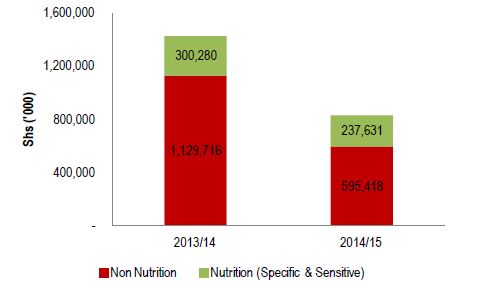
Lower LG agricultural advisory services (i.e., NAADS), district production management services, and technology promotion took the largest share of production sector nutrition–related allocation (see annex 2). Under NAADS, the government is providing agricultural inputs, such as seeds for food production. They promote different food stuffs at households and encourage people to plant nutritious food.
Education Sector
The total education sector budget was Shs 10.0 billion in 2013/14 and Shs 16.6 billion in 2014/15; the amounts allocated for nutrition-related activities were Shs 216 million and Shs 281 million in 2013/14 and 2014/15, respectively (see figure 2.7).
Figure 2.7. Kisoro Nutrition-Related Education Sector Allocation
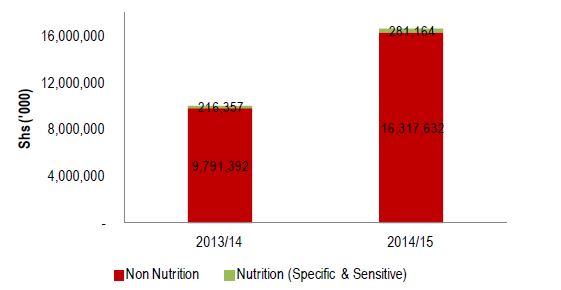
Tertiary, secondary, and primary teaching services take the largest share of nutrition-related allocation in the education sector (see annex 3). The education curriculum in primary, secondary, and tertiary education has topics on nutrition—especially biology and home economics—but they are very limited.
Water Sector
The total water sector—including the Water, Sanitation, and Hygiene (WASH) budget—as Shs 837 million in 2013/14 and Shs 923 million in 2014/15; the amount allocated for nutrition-related activities were Shs 83.7 million and Shs 92.3 million in 2013/14 and 2014/15, respectively (see figure 2.8). The large percentage of nutrition allocation in the water sector was to provide safe drinking water by constructing a piped water supply system; and promote sanitation and hygiene (see annex 4).
Figure 2.8. Kisoro Nutrition-Related Water Sector Allocation
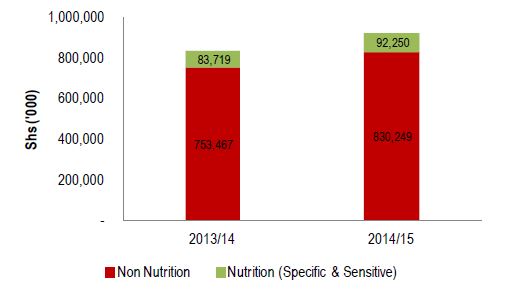
Community-Based Services Sector
The total community-based services sector includes gender and social development. The total community-based services sector budget was Shs 176.9 million in 2013/14 and Shs 213.4 million in 2014/15; the amount allocated for nutrition-related activities were Shs 17.7 million and Shs 21.3 million in 2013/14 and 2014/15, respectively (see figure 2.9). A large percentage of nutrition allocation in the community-based services sector was under operation of the community-based services department, and probation and welfare support (see annex 5).
Figure 2.9. Kisoro Nutrition-Related Community-Based Services Sector Allocation
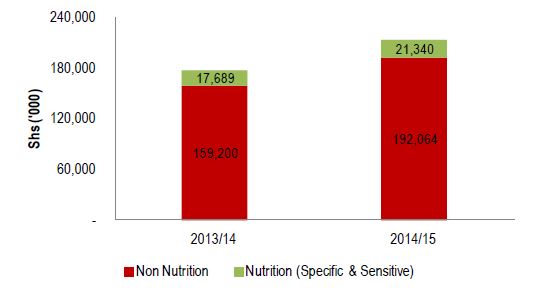
A number of key interventions are in this sector, including—
- training of communities in scaling up nutrition (under SPRING)
- orphans and vulnerable children (OVC)- training of caregivers on children feeding (under SUNRISE-USAID)
- development of sub-county OVC action plans
- emergency support to OVCs—including food; each child is given 20,000/= per quarter
- promoting backyard gardening
- functional Adult Literacy (FAL)—use of the program to propel nutrition action activities
- radio talk shows (every Sunday) emphasizing nutrition
- community driven development (CDD)—support for women and OVCs to form groups and benefit from CDD grants.
2.2.3 Nutrition by UNAP Strategic Area
As mentioned in section 1.1.1, the UNAP has 13 strategic areas, under five objectives. This analysis shows that the Kisoro district nutrition-related allocation was mainly related to strategic areas 1.1 (Promotion of access to and utilization of nutrition and health services to all women of reproductive age, infants, and young children); 2.1 (Increasing access to and use of diverse nutritious foods at the household level); and 4.1 (Strengthening the policy and legal frameworks for coordinating, planning, and monitoring nutrition activities, especially education and training on nutrition). Most of the allocation under these strategies is under health, production, and education, respectively.
On average, over the two FYs, 64.0 percent of nutrition-related allocation was under strategy 1.1; 18.0 percent under strategy 2.1; and 16.7 percent under strategy 4.1 (see figure 2.10).
Figure 2.10. Kisoro Nutrition-Related Allocation by UNAP Strategic Areas
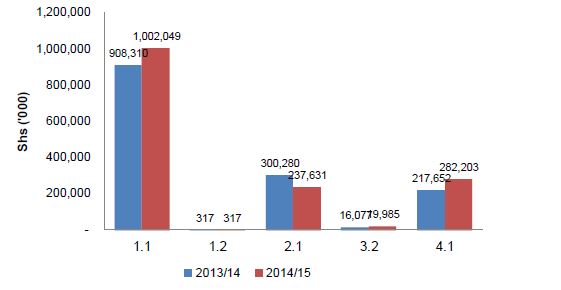
By and large, the UNAP strategic areas, which LGs are supposed to handle, have a large amount funding. These include 1.1, 1.2, 2.1, 3.2, and 4.1 (see table 2.3). These areas have significant funding because there is a direct link, with specific sectors, at the LG level. However, this funding is inadequate to make a significant impact at the local level.
Table 2.3. Kisoro Sector Nutrition-Related Allocation by UNAP Strategic Areas (figures in Shs ‘000)
| Sector | UNAP Area | 2013/14 | 2014/15 |
|---|---|---|---|
| Health | 1.1 | 824,592 | 909,799 |
| Production | 2.1 | 300,280 | 237,631 |
| Education | 3.2 | 100 | 356 |
| 4.1 | 216,257 | 280,808 | |
| Water | 1.1 | 83,719 | 92,250 |
| Community Based Services | 1.2 | 317 | 317 |
| 3.2 | 15,977 | 19,629 | |
| 4.1 | 1,395 | 1,395 | |
| Total | 1,442,637 | 1,542,185 |
Source: Author’s calculation based on Kisoro district sector work plans
The remaining eight strategic areas, especially 2.2 and 3.1, are not funded, partly because they are not part of a specific sector at the district level. Many of the activities in these areas are more suited for the regional- or national-level, such as development oversight of early warning surveillance systems and promotion of private-sector involvement in post-harvest handling.
2.2.4 Sources of Funding for Nutrition
The analysis shows that the government funded 65 percent in 2013/14 and 56 percent in 2014/15 of the total nutrition-related allocations. Nutrition-related allocation under the production (agriculture) sector was entirely funded by government (see table 2.4). Allocations under UNAP strategic areas 1.2 and 2.1 are also entirely funded by government (see table 2.5).
Table 2.4. Kisoro Sources of Nutrition Funding by Sector (figures in Shs ‘000)
| Sector | 2013/14 | 2014/15 | ||
|---|---|---|---|---|
| Gov’t | Gov’t & Donor | Gov’t | Gov’t & Donor | |
| Health | 331,544 | 493,048 | 334,377 | 575,423 |
| Production | 300,280 | - | 237,631 | - |
| Education | 216,357 | - | 271,857 | 9,307 |
| Water | 83,719 | - | 21,768 | 70,482 |
| Community-Based Services | 1,712 | 15,977 | 1,712 | 19,629 |
| Total | 933,612 | 509,025 | 867,345 | 674,840 |
Source: Author’s calculation based on Kisoro district workplans
Table 2.5. Kisoro Sources of Nutrition Funding by UNAP Strategic Areas (low) (figures in Shs ‘000)
| UNAP Strategic Area | 2013/14 | 2014/15 | ||
|---|---|---|---|---|
| Gov’t | Gov’t & Donor | Gov’t | Gov’t & Donor | |
| 1.1 | 415,262 | 493,048 | 356,145 | 645,905 |
| 1.2 | 317 | - | 317 | - |
| 2.1 | 300,280 | - | 237,631 | - |
| 3.2 | 100 | 15,977 | 356 | 19,629 |
| 4.1 | 217,652 | - | 272,896 | 9,307 |
| Total | 933,612 | 509,025 | 867,345 | 674,840 |
Source: Author’s calculation based on Kisoro district work plans
However, there is off-budget funding from donors or NGOs (such as Community Connector, SPRING, USAID-SUNRISE), which is not captured in the above analysis. In section 2.4, we capture some of the off-budget allocation.
2.3 Medical Supplies
Based on the information available from the NMS on drugs and medicines supply, Kisoro district received Shs 32.2 million in 2013/14 in essential nutrition supplies. Nearly half of the total supplies were for Health Centre (HC) IIIs (see figure 2.11). More than 87 percent of the value of supplies was spent on five supplies; glucose, ampicillin, vitamin A, ferrous sulphate, and mebendazle (see table 2.6). The values are low because NMS was unable to provide the full information on medical supplies for FY 2013/14 and FY 2014/15.
Figure 2.11. Kisoro District NMS Essential Nutrition Supplies by Facility Level
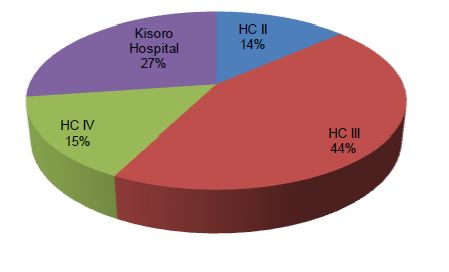
Table 2.6. Kisoro District NMS Essential Nutrition Supplies by Type
| Type | 2013/14 | Share |
|---|---|---|
| Ampicillin | 6,268,103 | 19.5% |
| Ferrous Sulphate | 4,283,077 | 13.3% |
| Folic Acid | 230,157 | 0.7% |
| Gentamycin | 1,312,906 | 4.1% |
| Glucose (Dextrose) | 7,455,042 | 23.2% |
| Mebendazle | 4,147,203 | 12.9% |
| Multivitamin Syrup | 512,246 | 1.6% |
| Vitamin A (Retinol) | 5,785,128 | 18.0% |
| Vitamin B Complex | 554,746 | 1.7% |
| Vitamin C (Ascorbic Acid) | 265,675 | 0.8% |
| Vitamin K1 (Phytomenadione) | 118,281 | 0.4% |
| Zinc Sulphate | 1,236,962 | 3.8% |
| Total | 32,169,526 | 100% |
Source: Author’s calculation based on NMS data
2.4 NGO and Development Partners Nutrition Allocation
A number of NGOs and DPs implementing projects are in the district, some of which have nutrition components. Despite the challenges of getting information on NGOs and DPs allocation, we managed to get data from six NGOs and DPs: Compassion, United Organisation for Batwa Development in Uganda (UOBDU), SPRING, Harvest Plus /Africa 2000 Network, RECO Industries, and FHI 360. The budgeted amount for FY 2013/14 was Shs 1.2 billon, of which Shs 1.1 billion was for nutrition. In 2014/15, the budgeted amount for FY 2014/15 was Shs 337.3 million, of which Shs 58 million was for nutrition (see table 2.7).
Table 2.7. Kisoro NGOs and DPs Total Project Budgets (figures in Shs ‘000)
| Name | Overall Project Budget | 2013/14 | 2014/15 | ||
|---|---|---|---|---|---|
| Total | Nutrition (Specific & Sensitive) | Total | Nutrition (Specific & Sensitive) | ||
| Compassion | - | 38,669,336 | 3,866,934 | - | - |
| UOBDU | 1,181,489,325 | 23,950,000 | 2,395,000 | 337,262,525 | 58,720,953 |
| SPRING | - | 928,450,777 | 928,450,777 | - | - |
| Harvest Plus/Africa 2000 Network | - | 38,072,375 | 38,072,375 | - | - |
| RECO | - | 88,841,863 | 88,841,863 | - | - |
| FHI 360 | - | 60,920,135 | 60,920,135 | - | - |
| Grand Total | 1,181,489,325 | 1,178,904,486 | 1,122,547,084 | 337,262,525 | 58,720,953 |
Source: Author’s calculation based on NGO & DP data
As shown in table 2.8, most of the NGOs and DPs are implementing activities, under UNAP strategic areas 1.1, 1.2, 2.1, 2.2, 2.3, 3.1, and 3.2. Most of their projects handle nutrition issues, with specific emphasis on food and reducing vulnerability to shocks.
Table 2.8. Kisoro NGO and DPs Funding per UNAP Strategic Areas
| NGO | UNAP Strategic Areas | Comment/s |
|---|---|---|
| Compassion | 2.1 | Nutrition takes a very small percentage in the organization activities. |
| UOBDU | 2.1 | The organization provides food to mitigate hunger among the Batwa communities. |
| SPRING | 1.1, 1.2, 2.1, 2.2, 2.3, 4.1, 4.2, 4.3, 5.1, & 5.2 | Implements purely nutrition activities. |
| Harvest Plus | 2.1 | No details provided. |
| RECO | 1.1 | No details provided. |
| FHI 360 | 1.1, 1.2, 2.1, 2.2, 2.3, 4.1, 4.2, 4.3, 5.1, & 5.2 | Implements only nutrition activities. |
2.5 Total Kisoro Nutrition Allocation
Based on the available data, the total amount of nutrition-related allocations in Kisoro during FY 2013/14 was Shs 2.6 billion and Shs 1.6 billion in FY 2014/15 (see figure 2.12). The reduction in total nutrition-related allocations is partly attributed to the unavailability of budget information from NGOs and NMS in 2014/15.
Figure 2.12. Kisoro Total Nutrition (specific and sensitive) Allocations by Funding Source

2.6 Observations
The district has a Nutrition Committee headed by the Chief Administrative Officer (CAO). There is a district nutrition focal person in the education department. Members were selected for the formation of the district nutrition committee according to their interest and support. The committee comprises mostly assistants or other members in the departments, but not necessarily heads of departments. Thus, most heads of departments are not aware of nutrition issues.
While interacting with the heads of sectors, it was evident that—apart from the District Health Office (DHO)—most of them were not aware of the UNAP and could not trace nutrition-related activities in the sector work plans and budgets. This was partly because the UNAP has not been well disseminated in the district. The low awareness of the UNAP means that nutrition was not prioritized in the sector budgets.
Coordination among stakeholders seems to be weak. A large number of civil society organizations (CSOs) are working on nutrition, but they work independently. This can be observed from the fact that the district nutrition focal person was aware of all the NGOs implementing nutrition projects in the district, which is leading to disjointed plans and actions on nutrition.
Summary of Findings, Conclusions, and Recommendations
3.1 Summary of Findings
According to available data, the total nutrition-related allocations in Kisoro District also fell—from Shs 2.6 billion in 2013/14 to Shs 1.6 billion in 2014/15. As in Lira district, the apparent reduction in total nutrition-related allocations in Kisoro can be attributed to the suspension of NAADS funding and the lack of budget information from NGOs and NMS in 2014/15. In 2013/14; NGOs budgeted nearly half (43 percent) of the nutrition allocation, none of which provided information for 2014/15.
Off-budget information provided by six organizations (Compassion, United Organization for Batwa Development in Uganda, SPRING, Harvest Plus/Africa 2000 Network, RECO, and FHI 360) implementing projects in Kisoro district shows that in 2013/14 and 2014/15, Shs 1.1 billion and Shs 58 million, respectively, was budgeted for nutrition-related activities. Again, this apparent drop in funding is mostly attributed to poor reporting by implementing partners in 2014/15. To complicate matters, the only NGOs and DPs that reported allocations for 2014/15 did not provide information for 2013/14, preventing a comparative analysis even among donors during the two years.
The total on-budget nutrition allocations for the four sectors named in UNAP and water increased from Shs 1.44 billion in 2013/14 to Shs 1.54 billion in 2014/15; this represents 8.0 percent and 6.1 percent, respectively, of total nutrition allocations within the five sectors. During 2013/14, the GOU funded over 65 percent of the on-budget nutrition-related allocation. This dropped to just over half (56 percent) in 2014/15. Nutrition-related allocations under education, water, and community-based services sectors were entirely funded by the GoU, as were on-budget allocations under UNAP Strategic Areas 1.2, 3.2, and 4.1.
NMS reported 32.2 million in 2013/14, nearly half of which was designated for essential nutrition supplies for HC III’s (sub-county-level health facilities), but failed to report its 2014/15 nutrition-related allocations.
Kisoro district nutrition-related allocations fell primarily under UNAP Strategic Areas 1.1 (averaging 64.0 percent of total allocations over the two years), 2.1 (18.0 percent), and 4.1 (16.7 percent).
3.2 Conclusions
TThe budget allocation to the four UNAP sectors and water is more than three-fourths of the total district budget; however, the share of nutrition-related allocations was only 8 percent in 2013/14 and 6.0 percent in 2014/15. It should be noted that most sector activities were nutrition-sensitive, with very little or no nutrition-specific. The district on-budget nutrition-related allocation was largely funded by CG transfers; which constituted over 60 percent of the total nutrition-related allocations.
The district nutrition-related allocation is mostly under UNAP strategic areas 1.1 (Promotion of access to and utilization of nutrition and health services to all women of reproductive age, infants, and young children); 2.1 (Increasing access to and use of diverse nutritious foods at the household level); and 4.1 (Strengthening the policy and legal frameworks for coordinating, planning, and monitoring nutrition activities, especially education and training on nutrition).
3.3 Recommendations
Based on study findings and analysis, SPRING offers the following recommendations, applicable to both Kisoro and Lira districts, for improving nutrition planning and budgeting at local government levels:
- Local governments should identify feasible mechanisms at the district and sub-county levels to provide adequate funding for Nutrition Coordination Committee operations. For example, recommendations from other PNB studies have suggested including a UNAP line item in district-level budgets (Pomeroy-Stevens et al. 2015; Adero et al. Forthcoming). Donor involvement may also help address the funding gap. However, interviews with district officials suggest that overreliance on unpredictable donor funds can make committee operations less effective.
- Local government should mainstream nutrition into development plans and budgets by—
- sensitizing stakeholders, including sector heads, on the UNAP
- modifying planning structures to ensure prioritization of nutrition (for example, include nutrition in the OBT)
- building knowledge and capacity of lower local government (LLG) officials around the planning, implementation, and budgeting of nutrition-related activities.
- Increase coordination among donors, CSOs, and District Nutrition Coordination Committees (DNCCs) to share annual funding levels for nutrition-related activities in a regular and transparent manner.
- The Ministry of Finance Planning and Economic Development (MoFPED) should include food security and nutrition in its local government allocations formula.
- Continue to advocate for CG prioritization of nutrition. District officials require instructions from the CG to integrate nutrition into their work plans and budgets. This could be accomplished in various ways, including UNAP introductory or sensitization workshops, budget analysis training for nutrition and budget staff, and dissemination of research briefs and key documents on nutrition.
Footnotes
1 Further attempts to rationalize this scale to a more standard breakdown of percentages will be made in the future.
References
Adero, Nancy, Edgar Agaba, Abel Muzoora, Daniel Lukwago, Hannah Foehringer Merchant, Alexis D’Agostino, Ezekiel Mupere, and Amanda Pomeroy-Stevens. Forthcoming. “District Technical Brief: Summary of Qualitative Findings in Kisoro and Lira Districts, Uganda - 2014 and 2015.” Pathways to Better Nutrition Case Study Evidence Series. Arlington, VA: SPRING Project.
Government of Uganda. 2011. Uganda Nutrition Action Plan 2011-2016: Scaling Up Multi-Sectoral Efforts to Establish a Strong Nutrition Foundation for Uganda’s Development. Kampala: Government of Uganda.
Kisoro District Local Government. 2011. “Annual Work Plan FY 2012/13.”
Kisoro District Local Government. 2011. “Annual Budget Estimates FY 2011/12.”
Kisoro District Local Government. 2011. “Annual Workplan FY 2011/12.”
Kisoro District Local Government. 2012. “Annual Budget Estimates FY 2012/13.”
Kisoro District Local Government. 2013. “Annual Budget Estimates FY 2013/14.”
Kisoro District Local Government. 2013. “Annual Workplan FY 2013/14.”
Lancet, The. 2013. “Executive Summary of The Lancet Maternal and Child Nutrition Series.” The Lancet Global Health 382 (9890).
MMucha, Noreen. 2012. Implementing Nutrition-Sensitive Development: Reaching Consensus. Briefing Paper #20. Bread for the World. Washington, DC: Bread for the World.
Pomeroy-Stevens, Amanda, Alex D’Agostino, Hannah Foehringer Merchant, Jolene Wun, Abel Muzoora, Madhukar B Shrestha, Nancy Adero, and Indu Sharma. 2015. “For the Long Haul: Financing Sustained Commitment to Nutrition.” Technical Brief. Pathways to Better Nutrition Case Study Evidence Series. Arlington, VA: SPRING. https://www.spring-nutrition.org/sites/default/files/publications/briefs....
SUN Donor Network. 2013. “SUN Donor Network: Methodology and Guidance Note to Track Global Investments in Nutrition.” http://scalingupnutrition.org/wp-content/uploads/2013/12/RESOURCE_TRACKI....
Uganda Bureau of Statistics (UBOS). 2014. “Uganda National Population and Housing Census 2014.” Provisional Results.